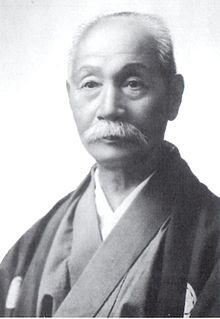Kusakabe Kimbei (日下部 金兵衛; 1841–1934) was a Japanese photographer. He usually went by his given name, Kimbei, because his clientele, mostly non-Japanese-speaking foreign residents and visitors, found it easier to pronounce than his family name.[3]: 8
Kusakabe Kimbei | |
|---|---|
| 日下部金兵衛 | |
 | |
| Born | November 24, 1841[1] or November 27, 1841[2] |
| Died | April 19, 1932[1] or April 19, 1934[2] |
| Occupation | photographer |
Career
editKusakabe Kimbei worked with Felice Beato and Baron Raimund von Stillfried as a photographic colourist and assistant. In 1881, Kimbei opened his own workshop in Yokohama, in the Benten-dōri quarter.[3] From 1889, the studio operated in the Honmachi quarter.[4]
By 1893, his was one of the leading Japanese studios supplying art to Western customers.[5] Many of the photographs in the studio's catalogue featured depictions of Japanese women, which were popular with tourists of the time.[5]: 10 Kimbei preferred to portray female subjects in a traditional bijinga style, and hired geisha to pose for the photographs.[6] Many of his albums are mounted in accordion fashion.[7][8]
Around 1885, Kimbei acquired the negatives of Felice Beato and of Stillfried, as well as those of Uchida Kuichi.[4] Kusakabe also acquired some of Ueno Hikoma's negatives of Nagasaki.
Kimbei retired as a photographer in 1914.[9]
Gallery
edit-
Country children
-
Kago Travelling Chair
-
Wringing the Tealeaves on the Furnace
-
Writing Letter (also known as Letter Writer)
-
Yumoto lake at Nikkō, Tochigi (日光市), Japan
-
Buddha statue at Hakone, Japan
-
Bell of Daibutsu in Kyoto
-
Japanese woman in jinrikisha
-
View of Mount Fuji. Hand-coloured albumen silver print, 1880.
-
Japanese Lantern Makers
References
edit- ^ a b c Nakamura, Hirotoshi (2006). 明治時代カラー写真の巨人 日下部金兵衛 (in Japanese). Tokyo, Japan: 国書刊行会. pp. 170–173. ISBN 4336047723.
- ^ a b "日下部 金兵衛 クサカベ キンベエ", 20-seiki Nihon jinmei jiten(20世紀日本人名事典) = Major 20th-century people in Japan : a biographical dictionary20世紀日本人名事典 (in Japanese), Tokyo, Japan: Nichigai AsoshieÌ"tsu., 2004, ISBN 4816918531, archived from the original on 2016-11-21, retrieved 2018-01-29
{{citation}}: CS1 maint: bot: original URL status unknown (link) - ^ a b Tucker, Anne, ed. (2003). The history of Japanese photography. Yale University Press in association with the Museum of Fine Arts, Houston. ISBN 0300099258.
- ^ a b Bennett, Terry (19 February 2013). Early Japanese images (1st ed.). Charles E. Tuttle. p. 50. ISBN 978-1462911370.
- ^ a b Wakita, Mio (2013). Staging desires : Japanese femininity in Kusakabe Kimbei's nineteenth-century souvenir photography. Reimer. p. 14. ISBN 978-3-496-01467-6.
- ^ Kincaid, Chris (6 May 2018). "Felice Beato and Kimbei Kusakabe, Photographers of 1800s Japan". Japan Powered. Retrieved 11 January 2019.
- ^ "Exhibition: Visual Arts of Japan". Georgetown University Library. Retrieved 11 January 2019.
- ^ Hockley, Allen (2010). "Globetrotters' Japan: People. Foreigners on the Tourist Circuit in Meiji Japan" (PDF). Massachusetts Institute of Technology Visualizing Cultures. Retrieved 11 January 2019.
- ^ Bennett, Terry (2012). Photography in Japan, 1853-1912. Tuttle Publishing. ISBN 978-1462907083.
Further reading
edit- Musée Nicéphore Niépce; Collection du musée Niépce. Thé/Laque/Photographie. Accessed 3 April 2006.
- Nagasaki University Library; Japanese Old Photographs in Bakumatsu-Meiji Period: "Kusakabe, Kinbei". Accessed 30 May 2008.
- Turner, Jane, ed. The Dictionary of Art, vol. 18 (New York: Grove's Dictionaries, 1996), 534.
- Union List of Artist Names, s.v. "Kimbei, Kusakabe". Accessed 3 April 2006.
External links
edit- Old Photos of Japan. Kusakabe Kimbei Archived 2010-09-27 at the Wayback Machine. A selection of photographs by Kusakabe, with footnoted descriptive text. Accessed 28 May 2009.
- I Photo Central. Kusakabe Kimbei Archived 2010-12-16 at the Wayback Machine. A selection of photographs by Kusakabe. Accessed 30 May 2008.
- Some of Kimbei Kusakabe's photos. At the Freer Gallery of Art and Arthur M. Sackler Gallery Archives.
- Fostinum: Photographs by Kusakabe Kimbei
- Photos of Japan. Kusakabe Kimbei Archived 2018-02-23 at the Wayback Machine. A collection of Japanese prints by Kusakabe Kimbei.
- Kusakabe Kimbei, photographs, Canadian Centre for Architecture